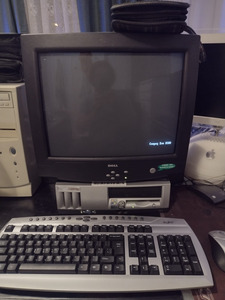First post, by Socket3
- Rank
- Oldbie
Hello vogons!
I've recently (last summer and autum) aquired a lot of PCI video cards, namely a couple of Hercules 3D Prophet II MX PCI and a Voodoo 3 3000 LC PCI witch I stumbled upon at the recycling center and a couple of "new" Geforce FX 5500 witch I got from Aliexpress and started using them in systems. The problem is they seem to perform quite poorly compared to their AGP variants.... is this common? I'll give a few examples:
- AMD K6-2 400MHz (6x66) on VIA VP3 mainboard + Hercules 3D Prophet II MX 32MB PCI, Detonator 12.9, win98se no service packs, 128MB PC133@66Mhz - Quake 2 demo1.dm2 @ 800x600 - 28.5 FPS
- AMD K6-2+ 400MHz (6x66) on VIA MVP3 + Aopen Geforce 2 MX 400 64MB AGP, Detonator 12.9, win98se no service packs, 256MB PC133@66Mhz - Quake 2 demo1.dm2 @ 800x600 - 41.8 FPS
- AMD K6-2+ 500MHz (5x100) on VIA MVP3 + Aopen Geforce 2 MX 400 64MB AGP, Detonator 12.9, win98se no service packs, 256MB PC133@100Mhz - Quake 2 demo1.dm2 @ 800x600 - 59.2 FPS
- Compaq EVO D500 SFF Intel Celeron 1300MHz (Tualatin, socket 370) + Geforce FX 5500 256MB PCI, Forceware 41.09, win98se no service packs, 512MB PC133@100MHz? - Quake 2 demo1.dm2 @ 800x600 - 91.7 FPS
- Intel Celeron 1300MHz (Tualatin, socket 378) / Abit ST6 + Soltek GeForce FX 5200 128MB AGP, Forceware 41.09, win98se no service packs, 512MB PC133@100MHz - Quake 2 demo1.dm2 @ 800x600 - 126.7 FPS
- Compaq EVO D500 SFF Intel Pentium 3 1400MHz (Tualatin, socket 370) + Geforce FX 5500 256MB PCI, Forceware 41.09, win98se no service packs, 512MB PC133@133MHz? - Quake 2 demo1.dm2 @ 800x600 - 109.2FPS
- Intel Pentium 3 1400MHz (Tualatin, socket 378) / Abit ST6 + Soltek GeForce FX 5200 128MB AGP, Forceware 41.09, win98se no service packs, 512MB PC133@100MHz - Quake 2 demo1.dm2 @ 800x600 - 144.2 FPS
Please take these results with a grain of sand since I didn't perform clean installs on these machines before testing, and there are cases like with the Compaq EVO where I can't set the memory speed like I can with the ABIT ST6 witch lets me run SDRAM at 133MHz even when the CPU is running at 100MHz FSB. I asume the Deskpro is running the memory at FSB speeds at all times.
Overall I noticed a significant decrease in performance when using a PCI video card - is this normal or did I screw something up?
I never had hands on with fast PCI video cards back in the day - they were much more expensive then their AGP variants in my country - so much so that all customers would prefer to trade in their PCI only mainboard for an AGP one + a difference in cash and get an AGP video card rather then pay a premium for the PCI version and be stuck with possibily no upgrade path later on. I don't really have much experience with them.









